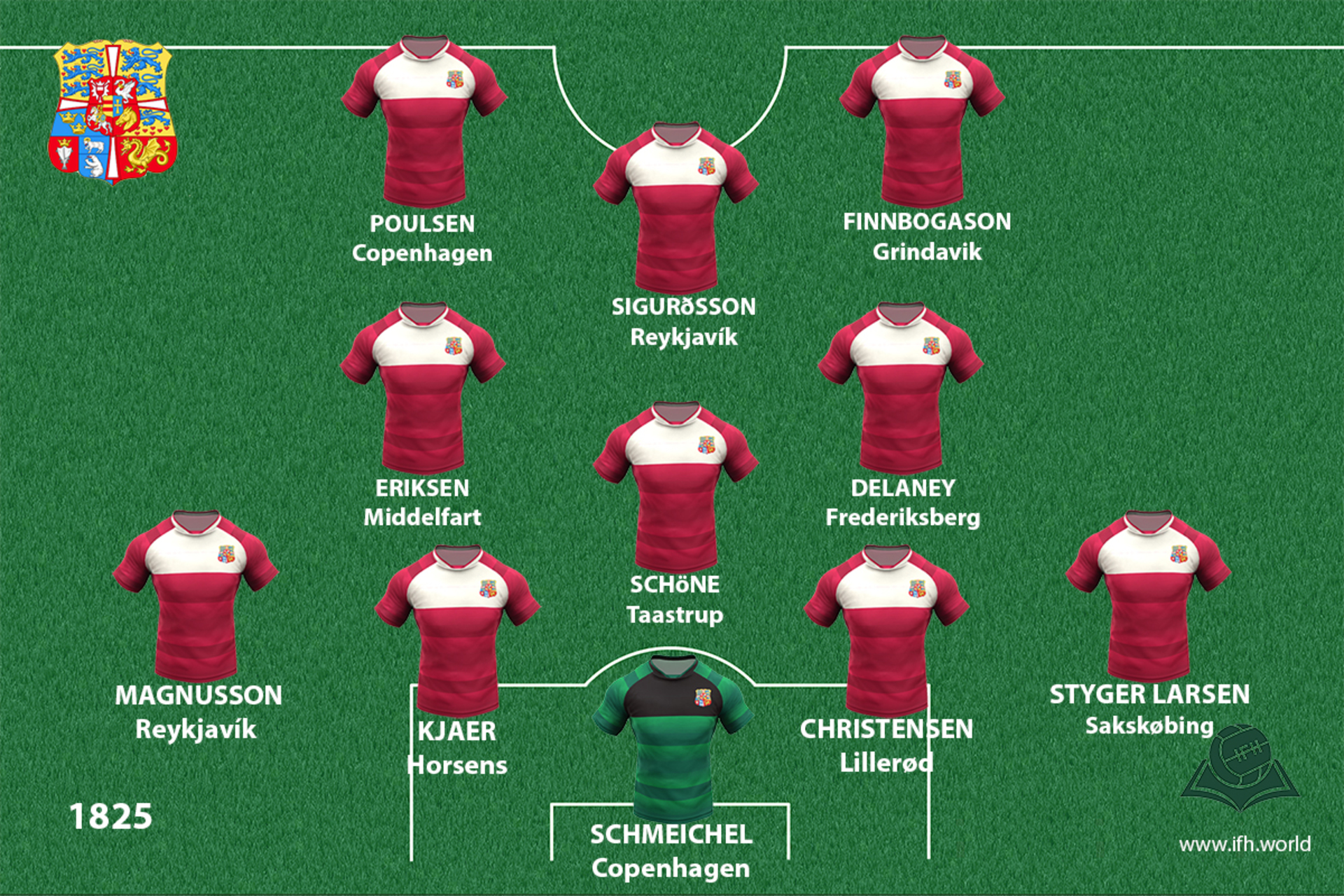Kingdom of Denmark
During the Napoleonic Wars, Denmark, afraid of the consequences, refused to pick sides, which led to the British fleet attacking it. Simultaneously Norway seceded from them.

Coat of arms

Shirt
| Position | First name | Last name | Mjesto rođenja | Like | Dislike | |
|---|---|---|---|---|---|---|
| GK | Jonas | LOSSL | Kolding |
0 |
0 |
|
| GK | Kasper | SCHMEICHEL | Copenhagen |
21 |
1 |
|
| DC | Frederik | SORENSEN | Copenhagen |
0 |
0 |
|
| DC | Jannik | VESTERGAARD | Copenhagen |
1 |
0 |
|
| DC | Raganr | SIGURðSSON | Reykjavík |
0 |
0 |
|
| DC | Simon | KJAER | Horsens |
1 |
0 |
|
| DRC | Andres | CHRISTENSEN | Allerød |
6 |
1 |
|
| DLC | Andreas | BJELLAND | Fredensborg |
0 |
0 |
|
| DLC | Hordur | MAGNUSSON | Reykjavík |
0 |
0 |
|
| DRL | Jens | STRYGER LARSEN | Sakskøbing |
0 |
0 |
|
| DR | Peter | ANKERSEN | Esbjerg |
0 |
0 |
|
| DR | Rasmus | KRISTENSEN | Brande |
0 |
0 |
|
| DL | Riza | DURMISI | Ishøj |
0 |
0 |
|
| DMC | Lasse | SCHöNE | Glostrup |
3 |
0 |
|
| MC | Aaron | GUNNARSSON | Akureyri |
3 |
0 |
|
| MC | Pierre | HOJBJERG | Copenhagen |
4 |
0 |
|
| MLC | Thomas | DELANEY | Frederiksberg |
3 |
0 |
|
| MRLC | Birkir | BJARNASON | Akureyi |
2 |
0 |
|
| AMC | Christian | ERIKSEN | Middelfart |
11 |
2 |
|
| AMC | Gylfi | SIGURðSSON | Reykjavík |
3 |
1 |
|
| AMRLC | Daniel | WASS | Gladsaxe |
2 |
0 |
|
| AMRLC | Jakub Bruun | LARSEN | Lyngby |
0 |
0 |
|
| AMRL | Emre | MOR | Brönshöj |
4 |
1 |
|
| AMRL | Johann Berg | GUDMUNDSSON | Reykjavík |
0 |
0 |
|
| AMRL | Sidney | SAM | Kiel |
0 |
0 |
|
| FRLC | Alfređ | FINNBOGASON | Grindavík |
0 |
0 |
|
| FRLC | Jon Dadi | BODVARSSON | Selfoss |
0 |
0 |
|
| FRLC | Martin | BRAITHWATE | Esbjerg |
0 |
0 |
|
| FRLC | Viktor | FISCHER | Aarhus |
4 |
0 |
|
| FRLC | Yussuf | POULSEN | Copenhagen |
4 |
0 |
|
| FC | Kasper | DOLBERG | Silkeborg |
5 |
1 |
|
| FC | Kolbeinn | SIGÞORSSON | Reykjavík |
0 |
0 |
|
| FC | Nicolai | JORGENSEN | Fredericia |
1 |
0 |
(Today part of: Denmark, Iceland, Schleswig and Holstein in Germany)
During the 19th century, Scandinavism appears among Danish and Swedish students – a literary, linguistic and cultural movement that supported various connections between Scandinavian peoples and countries. It focused on promoting the common Nordic past, common cultural heritage, religion and mythology, and common linguistic roots in the Old Norse language. During the 19th century, the power of the king of Denmark gradually decreased and Denmark became a constitutional monarchy after the revolutionary 1848.
Under the influence of nationalism and romantism in the first half of the 19th century, Icelandic national consciousness begins to develop. The greatest role in this was played by the writers gathered around the journal Fjölnir that was published in Copenhagen. They pointed out some Icelandic peculiarities such as keeping the old Norse custom for formation of last names from the name of the father and a suffix indicating the sex of the child (son or dottir). They pointed out the existence of their own, Icelandic, language that stems from the Western Norwegian dialect from the Viking age. They could also boast of being the only Nordic people who wrote down their myths and legends from the pagan times in poems known as eddas. Jon Sigurdsson (1811-1879) was a prominent politician whose diplomatic skill helped restore the parliament (Althing, 1848), and Iceland gained limited home rule in 1874.
Sources
- Felipe FERNANDEZ-ARMESTO, Narodi Europe, Zagreb, 1997.
- ''Denmark'', http://denmark.dk/en/~/media/Denmark/Documents/Society/History-2003-en.jpg
- ''History of Denmark'', https://en.wikipedia.org/wiki/History_of_Denmark#Christianity.2C_expansion_and_the_establishment_of_the_Kingdom_of_Denmark
- ''Scandinavism'', https://en.wikipedia.org/wiki/Scandinavism
- Coat of arms, https://en.wikipedia.org/wiki/Coat_of_arms_of_Denmark
